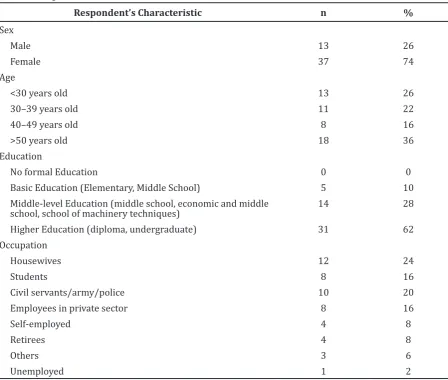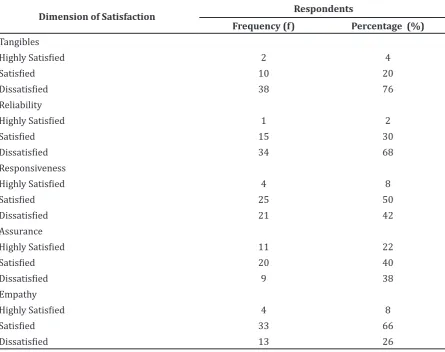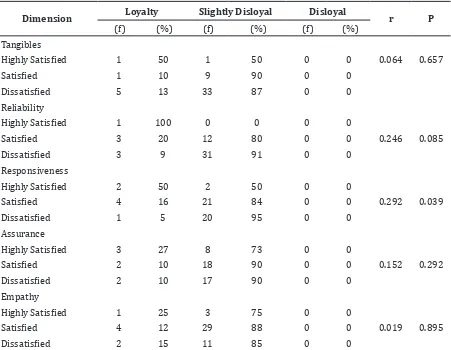Role of Satisfaction with Health Care Services in Increasing Patient
Loyalty: an Ambulatory Setting
Citra Restia Yusri,1 Marlianti Hidayat,2 Henni Djuhaeni3
1Faculty of Medicine Universitas Padjadjaran, 2Department of Oral Health Faculty of Medicine Universitas Padjadjaran/Dr. Hasan Sadikin General Hospital Bandung, 3Department of Public
Health Faculty of Medicine Universitas Padjadjaran
Abstract
Background: Health care providers must be able to provide services that can satisfy the patient. This encourages patient loyalty so that competitiveness can be preserved. This study aimed to examine the correlation of patients’ satisfaction to their loyalty towards health care facilities.
Methods: An analytic cross-sectional study was conducted on 50 respondents from Anggrek Specialist Polyclinic at Dr. Hasan Sadikin General Hospital Bandung (ambulatory setting) who met the inclusion criteria during the period of September to October 2014. Questionnaires that had been validated and tested for reliability were used. Rank Spearman test was used to analyze the correlation between patient satisfaction
and patient loyalty. This study used five dimensions of service quality to measure patient satisfaction, i.e.
tangibles, reliability, responsiveness, assurance, and empathy.
Results: The study showed that most (84%) patients felt unsatisfied and only 14% was loyal towards the health care services they received. Satisfaction and loyalty showed positive correlation with p=0.001 (p<0.05) and r=0.439, which showed a moderate correlation.
Conclusions: There is significant correlation between patient satisfaction and loyalty in Anggrek Specialist Polyclinic at Dr. Hasan Sadikin Hospital. This study can be an evaluative material for health care providers to
encourage improvement of service quality as to increase patient satisfaction and loyalty.
Keywords: Ambulatory, health care service, patient loyalty, patient satisfaction
Correspondence: Citra Restia Yusri, Faculty of Medicine, Universitas Padjadjaran, Jalan Raya Bandung-Sumedang Km.21, Jatinangor, Sumedang, Indonesia, Email: [email protected]
Introduction
Health care services as public services are highly dynamic in improving services to the response of changing consumers’ demand and tight competition among them.1 In doing so, every health care service institution try
to provide quality health services. One of the instruments to measure the quality of health
care services commonly used is the Service Quality (SERVQUAL) by Parasuraman et al. in Fandy Tjiptono and Gregorius Chandra2, the facets of SERVQUAL are tangible, reliability, responsiveness, assurance, and empathy.
Hospitals are one of the health care service providers which has the principle of trust, hence their success is highly depended on
the service quality, patient’s satisfaction,
and loyalty.3 Satisfaction is the feeling which comes after comparing one’s expectations and perceived experience. The measurement of
patient’s satisfaction can produce a result that
reflects patient’s perception and is a strong basis to improve service quality.4
Fandy Tjiptono and Gregorius Chandra2 mentioned that customer satisfaction is correlated positively with their loyalty and can potentially lead to increase income of the hospitals in the long term. This study was carried out to examine the correlation between patient satisfaction and their loyalty towards health care services in an ambulatory setting.
Methods
Polyclinic at Dr. Hasan Sadikin Hospital Bandung. Consecutive sampling was used to select 50 respondents during September and October 2014. The respondents who met the criteria were selected until the amount of the
sample was fulfilled. The inclusion criteria
in this study were: outpatients on the third visit or more to Anggrek Specialist Polyclinic, patients who came for check-up and patients who were older than 18 years old. Patients who refused to participate in this study were excluded.
The instrument used was a questionnaire
which had been tested for its validity and
reliability prior to its use. The questionnaire consisted of 25 questions to measure satisfaction: 5 questions for each dimension of service quality. This questionnaire enquired
about both the patient’s expectation and perceived experience. While to measure loyalty,
there were 4 questions. The questionnaire
was designed in the form of Likert scale with options: “agree to a large extent”, “agree”, “disagree”, and “disagree to a large extent”.
The variables examined in this study were patient satisfaction and loyalty. Satisfaction
could be measured in the five dimensions of service quality i.e. tangible (physical facility),
reliability (ability to provide the promised service), responsiveness (willingness to assist customers), assurance (employees’ knowledge, manner, and trustworthiness), and empathy (care towards the customers). Satisfaction was measured by using gap analysis, which means the difference between the expectation score and the perceived experience score.5 The lower the gap, the higher the level of satisfaction is and vice versa. The gap score was categorized
into three levels of satisfaction: highly satisfied (gap < 0), satisfied (gap = 0), and dissatisfied
(gap > 0). Patient’s loyalty was measured by
summing up the scores from each question
Table 1 Respondent’s Characteristic Distribution
Respondent’s Characteristic n %
Sex
Male 13 26
Female 37 74
Age
<30 years old 13 26
30–39 years old 11 22
40–49 years old 8 16
>50 years old 18 36
Education
No formal Education 0 0
Basic Education (Elementary, Middle School) 5 10
Middle-level Education (middle school, economic and middle
school, school of machinery techniques) 14 28
Higher Education (diploma, undergraduate) 31 62
Occupation
Housewives 12 24
Students 8 16
Civil servants/army/police 10 20
Employees in private sector 8 16
Self-employed 4 8
Retirees 4 8
Others 3 6
Table 2 Respondents Distribution based on Satisfaction Level
Satisfaction Level Respondents
Frequency (f) Percentage (%)
Highly Satisfied 5 10
Satisfied 3 6
Unsatisfied 42 84
Total 50 100
and then categorized into three: loyal (>75%), slightly disloyal (50-75%), and disloyal (<50%).
The data was analyzed using computer software. The non-parametric statistical analysis used the rank Spearman test since the measured variables were ordinal in nature. This analysis was used to check for any correlation between patient satisfaction and loyalty towards health care services in Anggrek Specialist Polyclinic at Dr. Hasan
Sadikin General Hospital Bandung. The
correlation would be considered significant if
p<0.05, and r value was used to examine the strength and direction of correlation based on Guilford criteria.
Results
The result showed that the majority (74%) of the respondents were female. Based on the
Table 3 Satisfaction Distribution Based on Dimensions of Service Quality
Dimension of Satisfaction Respondents
Frequency (f) Percentage (%)
Tangibles
Highly Satisfied 2 4
Satisfied 10 20
Dissatisfied 38 76
Reliability
Highly Satisfied 1 2
Satisfied 15 30
Dissatisfied 34 68
Responsiveness
Highly Satisfied 4 8
Satisfied 25 50
Dissatisfied 21 42
Assurance
Highly Satisfied 11 22
Satisfied 20 40
Dissatisfied 9 38
Empathy
Highly Satisfied 4 8
Satisfied 33 66
age groups, a large proportion (36%) was in the >50 years age group. Most respondents (62%) were with higher education and none of them was without formal education. Based on their occupation, the largest proportion was housewife, followed by civil servant, army, and police; there were also some respondents who were unemployed (Table 1). About 10%
of respondents were highly satisfied over the
health care service given by Anggrek Specialist Polyclinic, while the majority (84%) was
unsatisfied (Table 2).
If satisfaction was observed according
to the service quality dimensions, Empathy
and Assurance would be the dimensions with the smallest gap between expectation and perceived experience. Most respondents (76%) expressed their dissatisfaction with Tangibles (Table 3). Most respondents (86%) were slightly disloyal towards Anggrek Specialist Polyclinic and there were only a few who were loyal (Table 4).
In overall, the correlation between patient satisfaction and loyalty showed that a large
proportion of unsatisfied patients tended to
be slightly disloyal. The correlation between satisfaction and loyalty was measured from p-value=0.001 (p<0.05), and correlation
coefficient r=0.439 (Table 5). The satisfaction dimension with significant correlation to
loyalty was Responsiveness with p=0.039 (p<0.05) and r=0.292 (weak correlation), while other satisfaction dimensions showed
insignificant correlation to loyalty (Table 6).
Discussion
Patient satisfaction is important and widely used as an indicator of health care services
quality.6 Satisfaction is the comparison of patient’s expectation and perceived experience of health care services. Most patients were
unsatisfied and only a few patients were satisfied with the health care services they
received. This could occur due to the overly high expectations or perceived experience that
failed to fulfill their expectations. Furthermore,
from the education perspective, high education can also affect their expectations and perceptions towards the health care service they received. Bahrampour and Zolala7 showed that there is an inverse correlation between education background and level of satisfaction, which means a higher level of satisfaction is found more among respondents with lower levels of education. Improvement
of service quality is definitely required to
achieve a high level of patient satisfaction. Asian countries pay their health professional less than other countries, possibly reducing their motivation in providing better services and hence patient’s level of satisfaction.8
The dimensions in which patients showed the highest level of satisfaction were Empathy and Assurance. This showed that patients
were satisfied with the empathy shown by
doctors and nurses in the form of care and individual attention towards them. In addition, patients also expressed their satisfaction over Assurance which included the doctor’s Table 4 Respondents Distribution Based on Loyalty
Loyalty Respondents
Frequency (f) Percentage (%)
Loyalty 7 14
Slightly disloyalty 43 86
Disloyalty 0 0
Total 50 100
Table 5 Correlation between Satisfaction and Loyalty
Dimension Loyalty Slightly Disloyal Disloyal r P
(f) (%) (f) (%) (f) (%)
Highly Satisfied 2 40 3 60 0 0 0,439 0,001
Satisfied 2 67 1 33 0 0
knowledge, attitude, and ability to be trusted and believed by patients.
The dimension with the poorest level of satisfaction was Tangibles. This meant that
the patients were unsatisfied by the facilities, equipment, and presentation of health care
workers. This was due to the large number of patients complaining about the very poor toilet hygiene. Moreover, the patients faced
difficulties in finding free parking lots due to
the very limited parking area. The considerable number of patients at Dr. Hasan Sadikin General Hospital comes from all corners of West Java as it is the provincial referral hospital. Another factor would be the vehicles of the hospital staff that occupied too much parking space.
Another dimension with poor level of satisfaction was Reliability. One of the indicators was the specialist’s punctuality in managing the patients. The low level of satisfaction in this area could be due to the fact that the specialists in the polyclinic are also the teaching staff in charge of residents
and co-assistants. Furthermore, some of them have structural positions in the hospital management, restricting them from being punctual due to the teaching obligations or even citosurgeries. This problem forced the patients to unnecessarily wait for the doctors.
According to the study by Anbori et al.9, Empathy and Assurance dimensions,
which represent the quality of interpersonal communication, have a strong influence on
the patient’s motivation to return to the same health care facility. The manager of the health care facility should pay close attention to these
dimensions to improve the service quality
beside the physical facilities, so that patient’s loyalty towards the health care service can be increased.
The analysis of the correlation between patient satisfaction and loyalty in Anggrek Specialist Polyclinic revealed that most
unsatisfied patients were slightly disloyal. In general, the correlation was significant with
p=0.001 (p<0.05) and a moderate positive Table 6 Correlation between Satisfaction and Loyalty Based on Dimension of Service Quality
Dimension Loyalty Slightly Disloyal Disloyal r P
(f) (%) (f) (%) (f) (%)
Tangibles
Highly Satisfied 1 50 1 50 0 0 0.064 0.657
Satisfied 1 10 9 90 0 0
Dissatisfied 5 13 33 87 0 0
Reliability
Highly Satisfied 1 100 0 0 0 0
Satisfied 3 20 12 80 0 0 0.246 0.085
Dissatisfied 3 9 31 91 0 0
Responsiveness
Highly Satisfied 2 50 2 50 0 0
Satisfied 4 16 21 84 0 0 0.292 0.039
Dissatisfied 1 5 20 95 0 0
Assurance
Highly Satisfied 3 27 8 73 0 0
Satisfied 2 10 18 90 0 0 0.152 0.292
Dissatisfied 2 10 17 90 0 0
Empathy
Highly Satisfied 1 25 3 75 0 0
Satisfied 4 12 29 88 0 0 0.019 0.895
correlation (r=0.439) according to Guilford criteria.
This finding is supported by a study by
Mortazavi et al.10 , which shows that satisfied patients are more likely to be loyal towards the health care service. Another study in the
field of finance also produced similar results,
Oladele11 reveals that there is a correlation between customer’s satisfaction and loyalty. In addition, Fandy Tjiptono and Gregorius Chandra2 mention that patient satisfaction correlates positively with loyalty; therefore, it can potentially increase future income. Moreover, customer’s loyalty is crucial for health care service providers to be able to survive and compete with others because
attracting new customers is far more difficult
than preserving old customers.1
The correlation between the two variables was positive, meaning that the higher the satisfaction, the higher the patient’s loyalty was. However, the strength of correlation was only moderate. This was also indicated by
the relatively large number of highly satisfied
patients who were still slightly disloyal. Patient satisfaction does not guarantee loyalty, but it encourages loyalty. In some industries, almost 70% customers who have switched to another
firm are actually customers who are satisfied
by the previous service they received. They switch because of better prices and interesting promotions.12
Out of the five service quality dimensions, there was only one with a significant
correlation to loyalty, i.e. Responsiveness, with p=0.039 and r=0.292 showing a weak positive correlation.
In conclusion, there is a significant, positive
correlation between patient satisfaction and loyalty in Anggrek Specialist Polyclinic at Dr. Hasan Sadikin General Hospital Bandung. This study sought to provide some evaluative materials for health care providers so as to
keep improving their service quality, thereby
increasing patient’s satisfaction and loyalty. The limitations of the study are environmental factors which could affect the
patient’s perception of service quality, and
hence patient’s loyalty, such as the distance between the patient’s home and hospital, and
the patient’s health insurance that requires
him/her to seek treatment at certain hospitals only, have not been measured.
The author recommends further studies to add to this study and has some expectations for Anggrek Specialist Polyclinic to keep
improving its service quality in order to
increase patient satisfaction and loyalty, thereby maintaining its competence against other health care service providers.
References
1. Arab M, Tabatabaei SG, Rashidian A, Forushani AR, Zarei E. The effect of
service quality on patient loyalty: a study
of privete hospitals in Tehran, Iran. Iran J Public Health. 2012;41(9):71–7.
2. Fandy Tjiptono, Gregorius Chandra.
Service, quality & satisfaction. Yogjakarta:
Andi; 2005.
3. Ida Ayu Werdianingsih Kesuma, Djumilah Hadiwidjojo, Ni Luh Putu Wiagustini,
Fatchur Rohman. Service quality influence
on patient loyalty: customer relationship management as mediation variable Int J Bus Commer. 2013;2(12):01–14.
4. Mendoza AM. Correlation analysis of customer satisfaction and loyalty in Carlito Pena Reyes Hospital. APJMR. 2014;2(4):39–45.
5. Fredy Rangkuti. Measuring customer satisfaction. Jakarta: PT Gramedia Pustaka Utama; 2006.
6. Prakash B. Patient satisfaction. J Cutan Aesthet Surg. 2010;3(3):151–5.
7. Bahrampour A, Zolala F. Patient satisfaction and related factors in Kerman hospitals. East Mediterr Health J. 2005;11(5):905– 11.
8. Dayasiri, Lekamage. Predictors of patient
satisfaction with quality of health care in
asian hospital. Med J Aust. 2010;3(11):739– 44.
9. Anbori A, Ghani SN, Yadav H, Daher AM, Su TT. Patient satisfaction and loyalty to the private hospital in Sana’a, Yemen. Int J Qual Health C. 2010;22(4):310–5.
10. Mortazavi S, Kazemi M, Shirazi A, Aziz-Abadi A. The Relationship between patient satisfaction and loyalty in the private hospital industry. Iran J Public Health. 2009;38(3):60–9.
11. Oladele PO. Effect of customer satisfaction on customer loyalty among selected bank customers in Ado-Ekiti Metropolis, Niegeria. Interdiscip J Contemp Res Bus. 2012;3(11):228–36.



